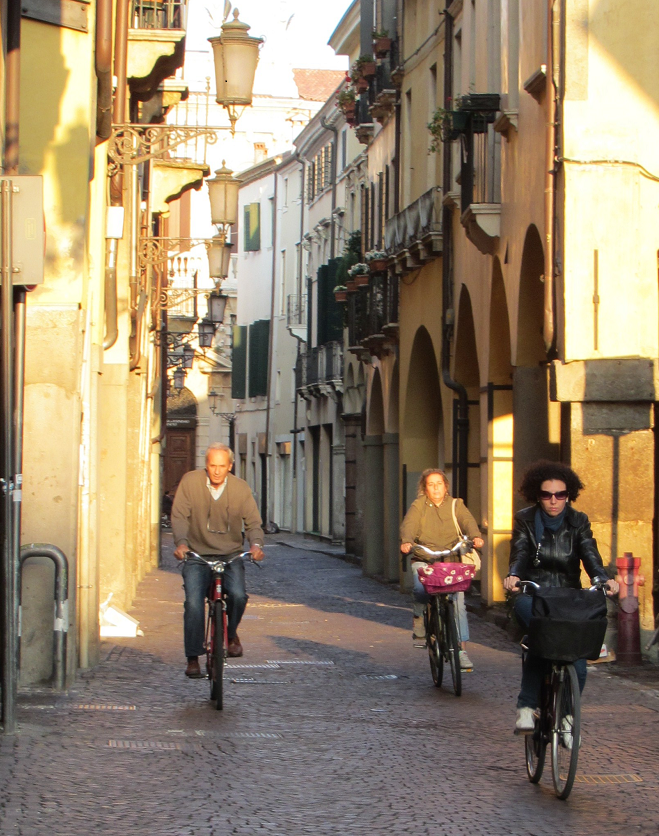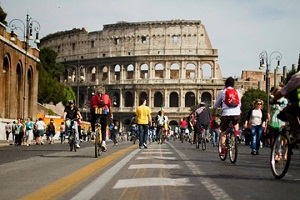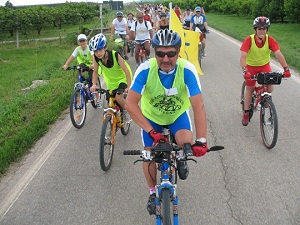
Member Of The Month - Italy: The Bike Honeymoon Has Just Begun
 Thanks to the efforts of FIAB, cycle modal share in Italy is increasing fast. Morning cyclists in Padua.
Thanks to the efforts of FIAB, cycle modal share in Italy is increasing fast. Morning cyclists in Padua.
(This feature is also available in Italian on the FIAB website).
Evidence suggests that there’s a resurging bike culture in Italy.
True, Europe’s 4thlargest economy hosts some of the big guns in the cycling industry as well as a handful of the globe’s best known and longest-running bicycle races. Yet, the relationship of the country’s masses with the bike, intended as an actual means of transport and not as a Sunday pastime, is only making a recent comeback from a couple of decades of relative oblivion (Italy’s cyclist modal share is 4.7%, below EU average of 7%). The Ministry of Infrastructures and Transports has recently announced that the number of people riding bikes on weekdays has tripled since 2001, and today 5m Italians cycle daily. Let’s try to break down the reasons which have led to this bike renaissance.
Changed economic landscape
The roots of Italy’s national cult of the car (there are still 60m motorized vehicles squeezed in the peninsula) must be sought in the economic boom of the 50es and 60es. Italians’ unfettered passion for motorized transport has continued till recent days, boosted by the optimism-driven policies of the 80es and 90es, when the ownership and use of a car was seen as emancipation from the oil-crisis-inducted austerity policies of the seventies. The situation quickly changed with the begin of the Global Financial Crisis: harsh austerity measures, the shrinking buying power of the masses and eventually a re-found pleasure for moderation are reshaping, among the other things, the mobility habits of the Italians. In 2011 and 2012 more bicycles than cars have been sold in Italy.
A generation of bike-savvy politicians
Italy is also undergoing a deep political transition, beginning from the biggest cities, whose Mayors – all in charge since 2011 or later, in facts a new generation of policy makers –miss no occasion to publicly support the use of bicycles. Ignazio Marino has caused sensation biking to his office on his first day as Mayor of Rome, and has soon announced a number of pro-cyclists measures, which join the city General Framework for Cycling, approved in April 2012 by the previous Council. Giuliano Pisapia has cut motorized traffic in Milan’s inner city with the introduction of a congestion charge, and planned to expand the cycle path network, while the city firmly ranks first nationwide for bike-sharing (187 stations, 3300 bikes). Luigi De Magistris is fighting against retailers lobbies and political opponents as he pedestrianizes a portion of Naples waterfront and introduces a 16 km city cycle path (where improvements, however, are needed). Big cities are following the good practices of smaller towns, where, especially in the North, sustainable transport is a reality (Reggio Emilia has 34.5 meters of cycle path per resident, Mantua and Lodi 26, Verbania24; Lucca has equipped its 10km-long path with charging stations for pedelecs; Bari’s rickshaw sightseeing is the city’s top attraction for tourists).
A public incentives scheme is starting to unfold as well: the Ministry for the Environment has introduced an incentive program aiming to stimulate purchases of bicycles and e-Bikes, refinancing it year in year out.
FIAB: leading the change
FIAB, the national ECF-affiliated cycling lobby, has played a crucial role in nurturing such changes. Founded 1989, it counts 16,000 members and 150 local committees. In 2012 FIAB was selected by ECF and the SRAM Cycling Fund to be one of the first participants in ECF’s cycling industry funded Leadership programme, aimed at small-to-medium sized organisations with a potential to significantly increase the impact of advocacy in their country. FIAB presented a business plan to launch several impactful new campaigns: timing was perfect as the campaigns and the funding arrived in time to prepare FIAB for the Italian parliamentary elections and make many more politicians aware of the potential of cycling. FIAB’s activity is, indeed, frenetic, ranging from advocacy (among the law bills proposed: extension of the workplace personal injury insurance also to the bike commuting journey; conversion of disused railways into cycle path; introduction of a reviewed cyclist-friendly traffic code) to campaigning (events are staged on a weekly basis), to the promotion and upkeep of the national cycle route network (20,000 km planned, 6,000 already in place). Every year in May FIAB also carries out an urban cyclists census, the “Giretto d’Italia”: though run by volunteers it is the only consistent survey providing data to indicate a general increase of cycle mobility in the country’s major towns.
FIAB successes have been such that the Leadership Programme grant was renewed for another year. On current evidence FIAB’s ambitious target of having a 20% cycle modal share by 202o isn’t out of reach. “By staging events and campaigns, we provide people with an opportunity to try a new lifestyle. Some of them like it and adopt it”, notes Giulietta Pagliaccio, who chairs FIAB since last April. Apparently, lobbying in Italy requires a whole lot of work. “The instability of Italy’s political scenario is our biggest challenge”, she notes. “Both at local and national level our policy counterparts change all the time, and gaining the trust of new people again and again is quite a demanding job”.
Bike for tourism
With its endless number of destinations, in facts, Italy has all that’s needed to develop a solid bike tourism market. Eurovelo routes 5, 7 and 8 cross the country, and FIAB’s Bicitalia network aims to provide bike travelers with thorough, updated information on the national cycle routes and the accommodation opportunities nearby.
The national bike industry
Italy’s bicycle and components industry has a reputation for quality. An overall number of 2,190,075 bicycles were produced in 2012 but the most impressive figures come from the export. € 144m worth in bikes, € 464m in components (+15.7% from 2011) were sold abroad, with a positive trade balance of € 161m. There are potentially huge growth opportunities for the domestic market. Piero Nigrelli, head of bicycles at the ANCMA (Association for Bike and Motorcycle Industry) knows whom to take as a model. “Germany boasts some seven million cycling tourists a year who generate € 9bn in turnover”. Italy seems a large market – but in facts the bike industry considers it underdeveloped in comparison with Denmark, Netherlands and the like. If the correct pro-bike policies are put in place, simplifying, protecting and enhancing everybody’s riding experience, Italy and its 60m inhabitants can represent the next goldmine for the bike business.
About the Author

Alessio Punzi is a Communications Assistant at the European Cyclists’ Federation. He has a Master's Degree in Sports Management and has previously worked in Rome for a sports events firm. His interests focus on the health benefits of cycling, the related savings for health services and the corresponding EU policies.
- Log in to post comments
Contact the author
Recent news!
Upcoming events
Contact Us
Avenue des Arts, 7-8
Postal address: Rue de la Charité, 22
1210 Brussels, Belgium











